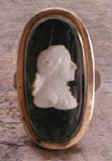 Mourning
Rings Mourning
Rings 
Mourning
jewelry, commemorating the death of a loved one, family
member or celebrity, has been around for centuries.
Especially popularized by Queen Victoria in the 1800s when
her lover, Prince Albert died; mourning jewelry became mass
produced and popularly worn as well as sentimentally worn.
One of the more important mourning jewels is the memorial
ring. Rings were often designed before someone’s passing, then according to
the will, left to family and friends. In Shakespeare’s
will, c. 1616, he makes provisions for his daughter and wife
to be given memorial rings inscribed, "Love My
Memory". An excerpt from the will of Anne Lady Newgate
of Arbury, c. 1637 is a perfect example of how memorial
rings were distributed:
often designed before someone’s passing, then according to
the will, left to family and friends. In Shakespeare’s
will, c. 1616, he makes provisions for his daughter and wife
to be given memorial rings inscribed, "Love My
Memory". An excerpt from the will of Anne Lady Newgate
of Arbury, c. 1637 is a perfect example of how memorial
rings were distributed:
"Item my Will and desire is to have a few playne gould
Rings made of tenne or twelve shillings price with a pansie
being my father’s Crest, engraven on the outside and two
letters for my name enamelled with blacke on either side the
pansie and an inscription within to be lattyn these words
followinge ‘Death is the beginninge of life’; and to be
delivered unto soo manie of my friends as a memorie of my
love as I heare nominate.
-Gossip from a Muniment Room, Being Passages in the Lives of
Anne & Mary Fytton 1574-1618
Decorated with symbols of mourning and remembrance, such as
the weeping willow, broken columns, urns and classical
figures, often the rings would be personalized by an
inscription of the name of the deceased, their birth and
death dates. Mourning rings of the latter half of the 1700s
strongly felt the popular culture’s fascination with
classicism, often using a figure stretched out over a tomb
or walking with head in hands. A good example of this is
a1786 ring depicting a painting of Hope, her chin in hand.
Hope is sitting beside a tomb with an urn perched atop on
which are the words, "Sacred to Friendship".
Memento Mori rings, reminders of physical death, were worn
to remind one of a lover of family member who was still
living, to appreciate life was fleeting especially with the
onset of the Black Death. Lady Jane Grey’s sister,
Catherine, who passed on in 1568, presented to her husband
while still living a ring engraved with a death’s head and
inscribed, "While I Live Yours". James Power had a
premonition of his own death so in a letter to his fiancée,
Julia Woodforde in 1818, he describes the ring he buys for
her in order to remember him by:
"I purchased yesterday a Diamond Mourning Ring, I will
place a brade of your hair and mine in it. On the inside I
will inscribe, ‘James T. Power died ----‘…if this
should be my fate you will… get it [the date] fill’d up
and I have no doubt you will regard the ring with affection
and wear it on my account."
-Woodforde Papers and Diaries
Good examples of memorial rings today are rare and important
jewels and not easily found on the open market. They do once
in a while come up at auction or may be found at a fine
antique jeweler however the prices reflect their rarity.
These rings are an important piece of not only jewelry
history but also our social history, displaying clearly the
need to face death and the need to be remembered.
from
Poe's
Attic |